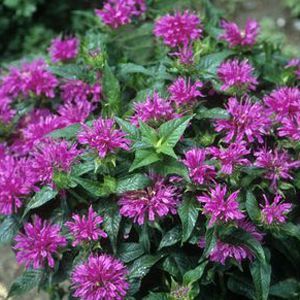The Bee Balm Plant
Do you have a wet area in your landscaping where whatever you plant seems to struggle? Bee balm might be the solution for you. Bee balm is one of the better plants for wet ground for those seeking good floral color.
But bee balm is about more than just aesthetics. This herb has its place in the kitchen cabinet and the medicine cabinet, as well. Its taste in tea is refreshing. Bee balm can also be applied to treat skin irritations.
Plant Taxonomy of Red Bee Balm:
Plant Type:
Monarda didyma plants are herbaceous perennials. They are also considered “herbs” in the sense that they have been put to culinary and medicinal uses. They are, indeed, in the mint family; their aromatic leaves have a minty fragrance.
Monarda didyma plants are herbaceous perennials. They are also considered “herbs” in the sense that they have been put to culinary and medicinal uses. They are, indeed, in the mint family; their aromatic leaves have a minty fragrance.
Characteristics of Red Bee Balm:
Red bee balm plants produce clusters of scarlet, tubular flowers in mid to late summer. These long-blooming perennials reach 3 feet or more in height.
Planting Zones for Red Bee Balm:
Red bee balm plants can be grown in planting zones4-9. These flowers are indigenous to eastern North America.
Red bee balm plants can be grown in planting zones4-9. These flowers are indigenous to eastern North America.
Sun and Soil Requirements:
Plant Monarda didyma flowers in full sun to partial shade and in a moist but well-drained soil. Use soil amendments such as compost to enrich the soil for your Monarda didyma plants.
Plant Monarda didyma flowers in full sun to partial shade and in a moist but well-drained soil. Use soil amendments such as compost to enrich the soil for your Monarda didyma plants.
Outstanding Characteristic:
This will depend on your gardening interests. If you simply enjoy beautiful flowers, then the “spiky hairdo” of the unusual flower clusters will be a chief selling point. If you seek plants that attract wildlife, then you, too have a reason to grow this perennial (see below). Herb aficionados, meanwhile, have their own reasons for growing Monarda didyma flowers (see below).
This will depend on your gardening interests. If you simply enjoy beautiful flowers, then the “spiky hairdo” of the unusual flower clusters will be a chief selling point. If you seek plants that attract wildlife, then you, too have a reason to grow this perennial (see below). Herb aficionados, meanwhile, have their own reasons for growing Monarda didyma flowers (see below).
Wildlife Attracted to Monarda Didyma:
Looking for plants to attract hummingbirds and butterflies? Red bee balm is commonly grown for just this purpose. It also attracts bees to help pollinate your other plants.
Looking for plants to attract hummingbirds and butterflies? Red bee balm is commonly grown for just this purpose. It also attracts bees to help pollinate your other plants.
Uses:
These flowers are also a useful option in moist spots where other perennials might struggle, as they are fine plants for wet ground. In addition to their employment for aesthetic purposes in the landscape, these plants have culinary and medicinal uses. Culinary herb growers will love the refreshing, unique taste of bee balm in tea. Medicinally, Monarda didyma “is used as a skin wash for rashes and other irritations. Yes, the pulverized leaves truly can be used as a “balm” to treat bee stings (thus the primary common name).
These flowers are also a useful option in moist spots where other perennials might struggle, as they are fine plants for wet ground. In addition to their employment for aesthetic purposes in the landscape, these plants have culinary and medicinal uses. Culinary herb growers will love the refreshing, unique taste of bee balm in tea. Medicinally, Monarda didyma “is used as a skin wash for rashes and other irritations. Yes, the pulverized leaves truly can be used as a “balm” to treat bee stings (thus the primary common name).
Care for Red Bee Balm:
Divide plants every few years in early spring to counteract their tendency to spread aggressively. They are susceptible to powdery mildew, especially in late summer; if your Monarda didyma plants succumb to powdery mildew at this time, it’s best to trim them back to the ground and properly dispose of the cut growth. Deadhead bee balm flowers to promote re-blooming.
Divide plants every few years in early spring to counteract their tendency to spread aggressively. They are susceptible to powdery mildew, especially in late summer; if your Monarda didyma plants succumb to powdery mildew at this time, it’s best to trim them back to the ground and properly dispose of the cut growth. Deadhead bee balm flowers to promote re-blooming.
Answer: Hi Nancy, believe it or not, there are many solutions to your problem. I would suggest constructing a decorative bed around the base of the tree about the circumference of the tree canopy. Once your new bed border is installed you can then till and prep the area with a good organic soil conditioner. Now you’re ready to plant. I would suggest an evergreen Fern to soften the trunk such as Holly fern or Autumn fern, then as a lower tier, you may want to consider a splash of Hosta Lilies that are perennially mixed in with some evergreen Mondo grass or Liriope ground cover to fill in the area. Last but not least a 3rd tier isolated border about 6-12 inches inside your original border to plant colorful annuals you could change out a few times a year when needed.
You now have a beautiful 3 tier landscaped accent tree bed and no more mud! Until next time…Happy Gardening!!
Jimmie

